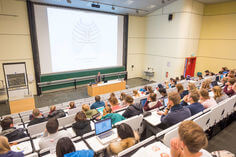- Institut
-
Herz- und Kreislaufphysiologie
- Markus Hecker
- Thomas Korff
-
Hugo H. Marti
-
Forschung
- Zelluläre und molekulare Mechanismen der postnatalen Entwicklung des zerebralen Gefäßsystems
- Die Bedeutung der molekularen PHD-HIF Achse für den akuten Schutz und die langfristige Regeneration nach einem ischämischen Schlaganfall
- Charakterisierung und gezielte Aktivierung von NRF2-abhängigen antioxidativen Mechanismen beim akuten Schlaganfall
- Extrazelluläre Nukleinsäuren als Trigger neuroinflammatorischer Prozesse in akuten und chronisch degenerativen Erkrankungen des Zentralnervensystems
- Neuroprotektion und Neurogenese
- Blut-Hirn-Schranke
- Publikationen
- Personal
-
Forschung
- Andreas H. Wagner
- Neuro- und Sinnesphysiologie
- Lehre
- Zentrale Einrichtungen
- Bernard Katz Lecture
- Stellenangebote
- Aktuelles
Research
Lin11-Isl1-Mec3 Domain Proteins as Mechanotransducers in Endothelial and Vascular Smooth Muscle Cells
Hypertension is one of the leading causes of morbidity and mortality worldwide. It is a major risk factor for cardiovascular events such as stroke, myocardial infarction, and heart or kidney failure. Although clinical implications of hypertension in these diseases have been thoroughly investigated, little is known about the cellular mechanisms in the various affected organs at the onset of hypertension.
In arteries and arterioles, the chronic increase in arterial blood pressure eventually translates into an increase in wall tension, or biomechanical stretch. This can cause changes in gene expression in vascular smooth muscle cells, which initiate an inward remodeling process that results in arterial stiffening.
In the (left) heart, however, increased arterial blood pressure eventually leads to pressure overload, triggering a complex remodeling process of the left ventricle, comprising hypertrophy, myocardial stiffening, and fibrosis. Biomechanically stressed cardiac endothelial cells possibly play a role in this massive buildup of extracellular matrix by undergoing endothelial-to-mesenchymal transition (EndMT) to an intermediate phenotype that spurs cardiac fibroblasts to myofibroblast differentiation.

Cells and stimuli causing and/or promoting endothelial-to-mesenchymal transitions (EndMT) of microvascular endothelial cells in the heart. NO, nitric oxide; ROS, reactive oxygen species; TGFβ, transforming growth factor β ; Treg, regulatory T cell. (Al-Hasani J, Hecker M. Cardiac Microvascular Endothelial Cells and Pressure Overload-Induced Cardiac Fibrosis. In Cardiac and Vascular Biology, vol. 9. Springer, 2023, pp229-264)
Focal adhesions represent an important interface between cells and the extracellular matrix. In vascular cells, LIM domain-containing proteins (Sporkova et al., 2021) residing at these focal adhesions are capable of translocating to the nucleus, where they regulate most stretch-sensitive genes. Zyxin was the first LIM domain protein shown to shuttle between focal adhesions and the nucleus (Wójtowicz et al., 2010; Babu SS et al., 2012; Cattaruzza et al., 2004) . It displays three C-terminal LIM domains, a leucine-rich nuclear export signal (NES), and N-terminal features that support its association with the actin cytoskeleton. In the cytoplasm, zyxin promotes actin assembly and organization as well as cell motility.
Our previous work has shown that ubiquitious loss of the Zyx gene in mice subjected to experimental hypertension causes extensive cardiac fibrosis and in turn a heart failure with preserved ejection fraction (HFpEF)-like phenotype that is reminiscent of restrictive cardiomyopathy in humans (Al-Hasani et al., 2022). We suspect that EndMT in Zyx-deficient microvascular endothelial cells and/or increased differentiation into myofibroblasts of Zyx-deficient cardiac fibroblasts is responsible for the excessive interstitial and perivascular fibrosis in the left ventricle of the heart that characterizes this phenotype. Interestingly, no apparent vascular phenotype could be detected in these animals. Our present work aims at unravelling which cardiac cell type and which signal transduction mechanism in these cells is primarily affected by the loss of zyxin. To this end, we have established corresponding cell-specific in vitro and in vivo model systems, which in our opinion are unique worldwide.
In both human and murine cultured vascular smooth muscle cells, Zyx downregulation or deficiency causes a shift in phenotype to the activated synthetic state (Gosh et al., 2015) that is prevented completely by overexpression of its most closely related family member, lipoma-preferred partner (LPP) (Sporkova et al., 2021). Zyx-deficient mice, however, do not reveal a vascular phenotype while LPP-deficient mice in fact show rather dramatic vascular phenotype when subjected to experimental hypertension, characterized by multiple dissecting aneurysms in the thoracic and abdominal aorta. Interestingly, this phenotype is both gender and age-dependent, and patients with abdominal aortic aneurysms prone to dissection show a decrease in LPP expression that is closely associated with a synthetic phenotype of the vascular smooth muscle cells. Moreover, arterial hypertension is a primary risk factor for patients with Marfan syndrome who develop aneurysms primarily in the ascending aorta. Loss of the Lpp gene in (murine) vascular smooth muscle cells causes a more pronounced shift towards the synthetic phenotype that is not only characterized by increased proliferation and migration but also by a significant contractile deficit. Thus, isolated perfused resistance-sized arteries from LPP knockout mice show a significantly reduced myogenic response, which is age-dependent but not gender-dependent, and not mirrored by ubiquitous loss of the Zyx gene. In addition, our work reveals that Lpp in the adult mouse is solely expressed by medial vascular smooth muscle cells in both conduit and resistance-sized arteries, while Zyx is expressed primarily by endothelial cells but also to a lesser extent than Lpp by the vascular smooth muscle cells of the media. A preference for Lpp expression in the media of the blood vessel is also apparent in humans (Sporkova et al., 2023).
In our opinion, it is intriguing that the loss or deficiency of two such closely related LIM domain proteins, which both possess (presumably distinct) mechanotransduction properties, results in such varied phenotypes of which at last one is also present in humans. Therefore, we have established corresponding cell-specific in vitro and in vivo model systems (in addition to zyxin) also for LPP to decipher which of its (mechanosensitive) target genes (proteins) in vascular smooth muscle cells are responsible for the observed dramatic weakening of the arterial vessel wall. We suspect, likewise to zyxin, that we will find them in the composition or reinforcement of the extracellular matrix.

Localization and putative mechanisms of action of zyxin in EC and LPP in vascular SMC. Note that the putative mechanism of action of LPP is derived from our findings on the mechanism of action of zyxin in vascular SMC. Both LIM domain proteins seem to serve the same function in vascular SMC, that is, to maintain their quiescent contractile phenotype. Note that there is no LPP expression in adult EC of mouse or human origin. αVβ3 and α5β1, corresponding integrins; LASP1, LIM and SH3 domain protein 1; MRTF-A, myocardin-related transcription factor A; PDLIM1, PDZ and LIM domain protein 1; PDLIM5, PDZ and LIM domain protein 5; SRF, serum response factor. (Sporkova et al., Front Physiol. 2021 Nov 19;12:769321)
- Institut
-
Herz- und Kreislaufphysiologie
- Markus Hecker
- Thomas Korff
-
Hugo H. Marti
-
Forschung
- Zelluläre und molekulare Mechanismen der postnatalen Entwicklung des zerebralen Gefäßsystems
- Die Bedeutung der molekularen PHD-HIF Achse für den akuten Schutz und die langfristige Regeneration nach einem ischämischen Schlaganfall
- Charakterisierung und gezielte Aktivierung von NRF2-abhängigen antioxidativen Mechanismen beim akuten Schlaganfall
- Extrazelluläre Nukleinsäuren als Trigger neuroinflammatorischer Prozesse in akuten und chronisch degenerativen Erkrankungen des Zentralnervensystems
- Neuroprotektion und Neurogenese
- Blut-Hirn-Schranke
- Publikationen
- Personal
-
Forschung
- Andreas H. Wagner
- Neuro- und Sinnesphysiologie
- Lehre
- Zentrale Einrichtungen
- Bernard Katz Lecture
- Stellenangebote
- Aktuelles



